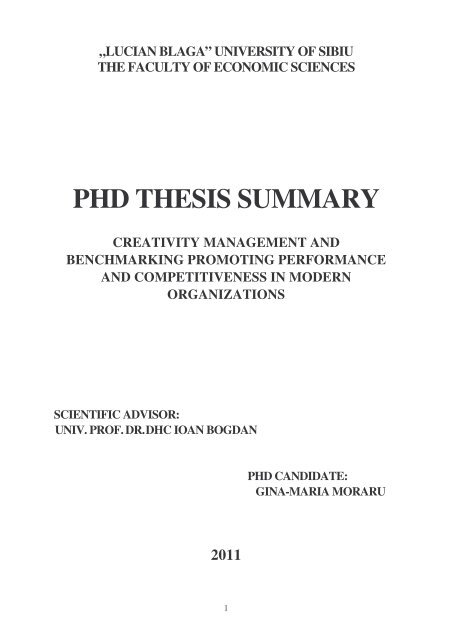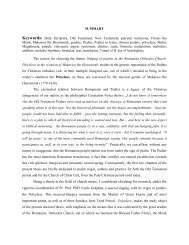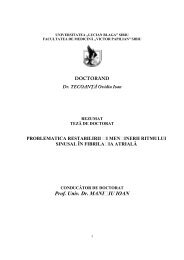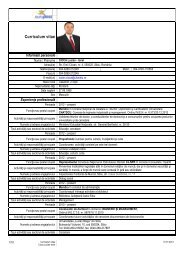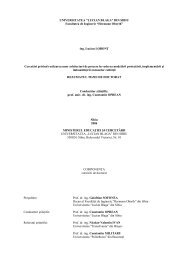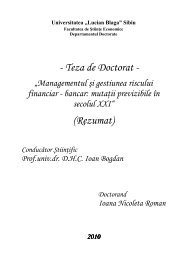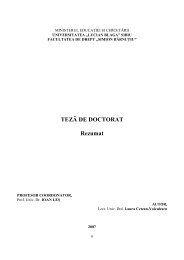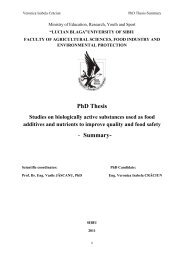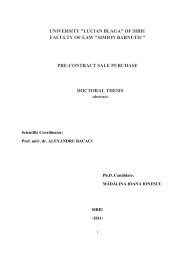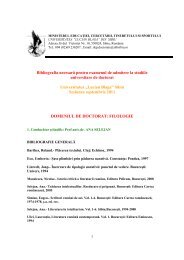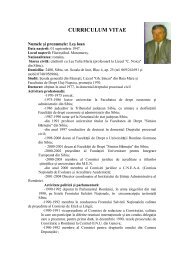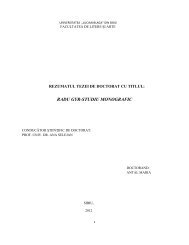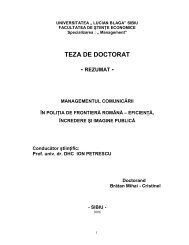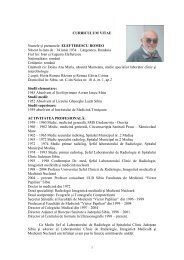Moraru Gina-Maria Phd Thesis Summary - Doctorate ULBS
Moraru Gina-Maria Phd Thesis Summary - Doctorate ULBS
Moraru Gina-Maria Phd Thesis Summary - Doctorate ULBS
You also want an ePaper? Increase the reach of your titles
YUMPU automatically turns print PDFs into web optimized ePapers that Google loves.
media etc) and keeping their anonymity – five of the Romanian successful companies,from different economic sectors, which skillfully used globalization as an opportunityto grow and improve performance. The final recommendation of research was thatRomanian managers quit the habit of focusing mainly on one direction – either oncreativity, or on modern management methods, such as benchmarking, in the case ofthe research done – and prove their distributive attention and ability for approachingproblems in parallel.Objective 15, advancing more efficient solutions for applying creativitymanagement and benchmarking in Romanian organizations, in order toovercome the current economic-financial crisis and the gaps between Romanianand the developed countries of Europe was mainly required by the downturn thatRomanian economy went through in the past period. This objective brings new facetsto the results obtained in objective 14, by reaching solutions regarding the currenteconomic-financial crisis. The objective is only partially solved in this part of thethesis, in §10.4, where more recommendations are given regarding the modification ofmarketing management, in the Romanian companies, by using creativity managementand benchmarking, recommendations that might represent a first incentive in order toovercome the crisis. Among others, we promoted the idea (of the authors) that thebiggest future challenge of marketing management will be not only to offer to clientsreally advanced products, with a high usage value, but also to offer the clients productswith really efficient products, ones that they can afford. Finalizing the objective wasdone in part IV of the thesis (selective scientific research regarding the realities andrequirements of creativity management and benchmarking, in the context of change, ofthe current crisis and modernizing of the Romanian economy and society) where, thesolutions proposed in §10.4 were completed by the ones offered by respondents forovercoming the financial crisis and the gaps between Romania and the developedcountries of Europe.Objective 16, a better identifying of the similarities and interactionsbetween marketing research, creativity management and benchmarking, andtheir integration in the factors that generate performance in the organizationmarketing, was chosen due to the more pregnant interaction between management,marketing and creativity, in the contemporary world, but also on the basis of thestronger and stronger overlapping of the instruments specific to managerial researchwith the ones specific to marketing research, for the development of the organization.The objective was achieved in chapter 11, by suggesting certain possibilities of usingthe marketing research as a managerial instrument, in various stages of creativethinking (fig 11.1) and by pointing out, in an original scheme, the common pointsbetween marketing research and benchmarking (fig. 11.2). These similarities allow thebeneficial integration of the marketing research – used as an extremely valuablemanagerial instrument – within the benchmarking processes, with beneficial results onorganizational performance. The objective was finalized by indicating severalpossibilities for using creativity and benchmarking in perfecting organizationmarketing (§11.3), among which we mention:11
the creativity matrix “Organizational resources – Managerial functions –Marketing mix” (fig. 11.3), a new tool aimed at orienting the activities oftransforming the resources of the company through creative and efficientperformance of the functions of management, in agreement to the final purposeof the modern organization: satisfying the needs of the client; deciding on the role that benchmarking plays within marketing management(fig. 11.4); enumerating the possible study subjects for the benchmarking processes startedin the annual marketing control plan.We would like to mention that this objective (16) is also the result of a previouswish of the authors, to bring down certain barriers (some fake ones), raised bymanagers or even specialists, between these two wonderful subjects which, if usedcorrectly, can lead any organization to success: management and marketing.In the current context of the occurrence and expansion of new types oforganizations, whose management has strong particular connotations, different fromthose of the classical organization management, objective 17 was absolutelynecessary: Promoting modern forms of organization, in which creativity andbenchmarking can amplify the performance of the organization – organizationand management on cost, profit and performance centers, networking, emergingcompanies and others. The objective was approached in chapter 12, where weanalyzed the organizational forms beneficial to developing creativity and usingmodern management methods, including benchmarking, with the aim to promote thevalues of the company.Due to the fact that, at a global level, the companies that produce and tradegoods-knowledge are those that adapt the best to the environmental changes, and at thesame time have high turnovers, it is required to find ways of evaluating thecontribution of creativity in the calculation methodology and the company’s valueincrease, which is why we defined this issue as objective 18. It was fulfilled in chapter13, when we approached the concepts of profit and value, pointing out the role ofcreativity and benchmarking in promoting them (in §13.2) and presenting a modernversion for calculating the value of the firm, one that comprises also a coefficient ofcreativity. The analysis of the relation market – profit – value and pointing out the roleof creativity in its development (in §13.3) completes the objective.Part IV – “Selective scientific research regarding the realities andrequirements of creativity management and benchmarking, in the context ofchange, of the current crisis and modernizing of the Romanian economy andsociety” is the material that constitutes the entire “path” the thesis went through: wherewe, the Romanians, are in creativity management and benchmarking and where weshould be in order to overcome all the challenges of a tough, competitive anddangerous business environment.The research was performed on four categories of respondents: PhD candidatesin management, university professors (who teach management related subjects atvarious faculties), managers and specialists in creativity management and/orbenchmarking from the organizations producing goods or services. It was considered12
There were respondents that emphasized also the necessity ofintroducing a system of performance indicators in the individual evaluation of humanresource, and possibly accompanied by processes of creativity benchmarking. Theseideas bring useful additions in reaching the first objective of the thesis, which is toanalyze the concepts of creativity and benchmarking, their evolution in time andtheir approach from the point of view of the requirements of the contemporaryworld. Moreover, an immediate requirement in the management of Romanianorganizations – mentioned by the respondents – was to create an efficient evaluationsystem which would allow an easier identification of creative persons, groups and“areas” in the organization, so that they can be coordinated efficiently in order toobtain value. These opinions come to support objective 18 of the thesis, which wasachieved, theoretically, in chapter 13, i.e. the contribution of creativity in thecalculation methodology and the company’s value increase. It is necessary to have a shift in the attitude of managers regardingknowledge and an intensification of the application of modern methodology, an aspectwhere many respondents insisted on:- stimulating managers in order to use creative thinking, training them in this respectand involving them in many national and international events (conferences,symposiums, partnerships etc.), aimed to keep them up to date regarding the fieldof management;- making managers aware of the necessity to develop a knowledge capital, to bettercapitalize on knowledge, especially export and the necessity of basing economicactivities not on production, but on the production of knowledge-goods;- spreading the conviction – among Romanian managers – that a specialized humanresource is the most valuable resource in the organization, the more so if it is alsocreative; it is recommended that managers even create a map of specialists thatwould help them transform knowledge in tangible goods, services and money,knowing at all times who is the best person they can turn to regarding an issue;;- stimulating a new entrepreneurial spirit – through mass information and seriousinvolvement of the Romanian education system – and creating a “trend” favorableto the appearance of knowledge entrepreneurs;- the necessity of introducing simulation – in virtual organizations, but also at thelevel of national economy – of more difficult situations that organizations or theeconomy could be facing in the future; this would allow a timely forecast of thepotential problems and efficient interventions for solving them even from anincipient phase, reducing the risk of crises or other major distortions of theeconomic, social and natural environment.We believe that this change in attitude and mentality of Romanian managers, isthe basic premise that allows the practical application in organizations of three of theobjectives of the thesis – the ones that were solved only theoretically in chapters 1 and2: objectives 2,3 and 4. Therefore, through the implementation of objective 2 –referring to The role of creativity and benchmarking in modernizing organizationmanagement – and objective 3 – connected to the implications of creativity andbenchmarking in changing the functions of management and the typology of15
modern organizations – companies will actually reach performance, would have acompetitive management: the creative organization led by the creativity manager. It isa symbiosis similar to the one in the specialized literature, which is the knowledgebased organization, led by knowledge managers.The implementation of objective 4 would consist of satisfying concrete cases ofthe creativity requirements of the management system of the organization, willactually determine the appearance of several creative decision makers, which wouldchose and lead to completion, in a fast and efficient manner, the optimum solutions forthe more and more varied problems which they are facing in the knowledge basedbusiness environment. However, all this is possible only if the development of a newview on knowledge and work methodology is developed. This is the first and the mostdifficult step towards management innovation. The most recommended systems, methods and management techniques tobe used by creativity management – according to the respondents – are benchmarking(in the first place), classical methods of creativity stimulation (in the second) andproject management (in the third). This conclusion leads to validating objective 8 ofthe thesis - promoting now methodological instruments in creativity management. The respondents also validated objective 9 of the thesis - advancingcertain solutions for a better use of benchmarking in the management ofcreativity, starting with the simultaneous use of benchmarking, internally andexternally, and ending with more ample changes in the phases or methodology ofbenchmarking, in its system of monitoring and control, in the system of access toresults, capitalizing on conclusions, and with the aim to better correlate it withcreativity management. Research has also collected important measures for growing theinfluence of creativity management and benchmarking in the functions oforganizations from the point of view of obtaining a competitive edge, thusvalidating objective 10 of the thesis (which was theoretically approached in §7.4). Wewould like to mention a few:- creating special funds, at an organization level, but also at a national one, allocatedfor long, medium and short term to research-development;- creating a national data base with inventions, innovations, inventors andorganizations involved in research (with contact data), as a first step in creating anational innovation benchmarking;- education based on creativity and the continuity from school to the active life in theorganization;- a clearer legislation, one that would stimulate the use of modern managerialmethods. The proposals that aim improvements connected to providing specializedliterature to organizations and raising the level of documentation of managers andemployees, are aimed at objective 11, a documentary scientific research regardingthe possibilities for capitalizing on the Romanian and foreign specializedliterature in using benchmarking for promoting creativity and organizationperformance. We would like to mention: the creation of electronic libraries,16
developing plans for purchasing the specialized literature, of reducing centralism, ofdiscarding the autocratic leading manner and increasing the degree of dissemination ofthe horizontal and vertical axes in the company, a periodic participation of managersand employees to trainings on a better use of knowledge and creativity, to internationalconferences and experience sharing etc. Using creativity and benchmarking in the context of businessglobalization and internationalization, is important to be firstly strategic and thentactical and operational. These “accelerators/influences of the process of globalizationand modernization” – and, as a great deal of respondents believe – must be put to gooduse by the management of change, by an efficient and creative leadership, but also, anational plan of support and competitiveness increase on sectors of business.Also in the context of globalization and internationalization, we would like tomention that the answers received at question 14 addressed to university professors,the same as question 16 for the managers and question 15 to the specialists (in annexes16.2, 16.3 an 16.4) were the foundation of research from secondary sources, fromchapter 10, §10.3, thus contributing to validating objective 14 of the thesis -documentary scientific research regarding the way in which creativity andbenchmarking can be a positive influence on the internationalization of theRomanian companies and their adaptation to the process of businessglobalization. It is necessary to have a better cooperation in the Romanian businessenvironment and its connection to the scientific environment, through intensifying thecooperation from the public, private and social sectors, with their active involvementin developing technological transfer chains. This solution is on of the ones thatcontribute before objective 15 of the thesis - advancing more efficient solutions forapplying creativity management and benchmarking in Romanian organizations,in order to overcome the current economic-financial crisis and the gaps betweenRomanian and the developed countries of Europe. It is important to develop, in all organizations, an organizational culturethat would facilitate a quick assimilation of change, based on the ancient values of theRomanian people: creativity and high ethics. This is possible through:- taking into consideration, apart from the intellectual capital, also the moral capitalof the organization and practicing a “common sense management”;- capitalizing on the knowledge of a creative people;- preserving in the organization the human values and creativity, of knowledgeacquired through experience and using them in the process of continuousimprovement; an essential aspect is represented by eliminating corruption;- creating a true organizational culture for the creative groups, based on combiningindividual work with team work, based on intense collaborations of the specialists indifferent and multicultural developments.The last idea supports that consensus of creativity placed in the service of theorganization in order to overcome difficult periods (such as the current crisis) which Iindicated in the end of paragraph 3.1, as a stimulating undertaking of the increase ofthe number, consistency and efficiency of creative groups in the organization.17
All these are solutions that complete objective 15 of the thesis, mentioned in thepoint above. The following eight conclusions below, (11-18) are conclusion of theselective research and also contribute to finalizing objective 15. it is necessary to intensify the international transfer of managerial andeconomic know how, through a series of measures that were listed in §16.1, at thecomments regarding question 1, point 5. A part of the respondents even suggested profound modifications in thetheory and practice of management, such as: creating an innovation developmentmodel, that includes creativity in the sustainable development mode, and creating anew function in the company, the knowledge function, or the opening of the knowledgemarkets. It is necessary to have a different manner of collecting and managinginformation and knowledge, in which benchmarking can play an active role: creatingdigital data bases in the company, but also at a national level, organized in areas ofinterest, updated bases following each benchmarking process that takes place. In theopinion of some respondents, this computerized system must be developed to the levelwhere benchmarking can be possible at any time, though the simple press of a button,from one of the terminals of the beneficiaries registered in such networks. Creativity management must be approached in an organized manner,starting with planning for stimulating, developing, protecting and using creativity,continuing with organising it, with generating and coordinating it and ending with acontrol-evaluation of creativity, in order to subsequently take the most recommendedmeasures of correction. Only in this way will the impact of creativity andbenchmarking grow regarding the functions of management and management ingeneral. Creativity must be oriented mainly towards the growth of the quality ofproducts and changing the attitude towards client, through:- promoting real quality and not using fake promotions;- using the creativity of the clients for creating and innovating products andprocesses;- a new approach of the long term business and reorganizing all processes accordingto the need of the client.These aspects do not only validate objective 15 of the thesis, as we mentionedpreviously, but also objective 13, which refers to the importance of the trianglemarketing – creativity – benchmarking in creating value in organizationmanagement, Actually, the respondents “designed” themselves an image of thistriangle, which is found in figure 16.52 of §16.1 The respondents noticed as being more and more stringent the necessityof certain transformations in the Romanian political-legal system and in its relationswith the economic environment. In this respect, promoting real competences,eliminating political nepotism and stimulating economic growth and employment bythe political-legal system are three basic pillars that can favor the development andusage of creativity.18
However, the organization led by professionals, not politicians, is only one ofthe objectives that need to be reached as soon as possible. Other two sets of measuresare required for the long term. The first consists of investing in education, allocatingfunds for long-life-learning in all fields of activity and for continuous formation ofteachers and professors. the second requires (we refer again to one of the quotations)“the substantial increase of the sums allotted to scientific research by the politicaldecision makers” and creating national research structures, on various fields,organized as consortiums. Creating a new type of management, capable of anticipating in due timethe requirements of change, and using creativity and benchmarking firstly tounderstand the relations among people and then to discover the paths to performance. Transformations in the organizational structure can become true “keys”for exiting the crisis, if we take into consideration the fact that the respondentsappreciated the organization on cost, profit and performance centers, slimorganization, creating a benchmarking department and a virtual department as one ofthe extremely favorable elements in developing and capitalizing on creativity in thecompany. These recommendations validate (apart from objective 15) also objective 17of the thesis - Promoting modern forms of organization, in which creativity andbenchmarking can amplify the performance of the organization – organizationand management on cost, profit and performance centers, networking, emergingcompanies and others. The solutions offered for eliminating the resistance of managers inusing benchmarking and the modern instrument of creativity managementwhichvalidated objective 19 of the thesis focused on these main directions:- free communication and training sessions for the managers, with the aim toacquire the methodology of benchmarking (maybe sponsored by projects won at anational levels), accompanied by promoting it (publicity in mass-media, pressarticles in specialized journals, creating a national magazines specialized on casestudies);- pointing out the advantages obtained by benchmarking by those that applied it(efficiency, performances obtained), and a comparative analysis of situations inwhich benchmarking was used and situations in which benchmarking was not used,on case studies;- giving rewards to the volunteer participants in the company;- experiment as an optimum method of convincing: involving managers in simulatedor real benchmarking processes, that take place at a small level, followed by the“financial evaluation of results”;- after managers were convinced to apply at least once benchmarking, it is required tohave a comparative study of the situation and the evolution of the organizationbefore and after the study.As for objective 20 of the thesis – suggesting ways of adapting Romanian educationin order to promote more intensively creativity and benchmarking inmanagement, the big number of solutions rendered the selection of the most19
epresentatives as being rather difficult. Chapter 16 gives some details. Here are,therefore, some suggestions:- decreasing the quantity of information that must be memorized, in favor of creativestudy, which triggers the ingenuity of students, and at the same time thedevelopment of lateral thinking in professors as well as students, by applying themethodology known in management for stimulating creative thinking;- a higher importance to practice and applications rather than theoretical classes;- reducing the use of the Internet in favor of other activities (visits in the library andin organizations, student conferences, workshops, etc.);- introducing the subject “creativity” in the curriculum;- all the analytical curricula must necessarily include minimum requirements ofcreativity;- creating a new system for evaluating young persons in schools/universities, basedon creativity and ethics – banning cheating in examinations and plagiarism in thehomework or projects etc., at the same time applying the punishments foreseen inthe rule book;- modifying in time the areas of teaching and the subjects, according to the newestdiscoveries and the development requirements of the Romanian economy, inrelation to the education necessities of students, correlated with the long termdemands of the labour market, and not done according to the wishes/interests ofprofessors;- increasing the autonomy and rewarding of professors, at the same time the ethicsrequirements and the seriousness demanded from them; this would lead to anincrease in the quality of the teaching process and a reduction of the practices oftutoring;- creating schools of inventions;- the necessity to introduce benchmarking processes among schools and universities. Even if the opinions of the respondents were rather different regardingthe issues that creativity management and benchmarking are being faced with,nowadays, in Romania, the converge towards a set of problems presented in table 16.6in over 50 categories, with different solutions, and which can be found in allparagraphs of Chapter 16, in the answers received at various questions. Applying in the organization a truly efficient creativity management,based on benchmarking processes, requires – in the opinion of many respondents –creating a manual of benchmarking in the company, with the results of the processes,which constitute new problems (what should I do to be better). This can be followedby a manual of creativity of the company. At first, it will be a simple data base withachievements/failures, successes/defeats; in time, instructions and procedures forstimulating the group and organizational creativity will appear, similar to the ones inthe Manual of quality, but un-standardized, flexible, adaptable to the different businesscontexts.We considered fit that this part of the thesis concludes with a chapter or partialconclusions (chapters 4, 9, 14 and 17), which point out the essence of each part andbring to the foreground the original contributions of the author. The summary of these20
chapters is found (after acquiring the new meanings, resulted from their corroboration)in a complete and compact form, in part V of the thesis “The summary of conclusions,opinions, solutions and personal contributions”.The selective bibliography, list of terms and the list of graphic forms andannexes complete this five part structure, the leading thread of it being the intention toconvince any reader on the increased importance that should be given in the Romanianeconomy, to creativity management and benchmarking, especially now, in an effort toovercome the current economic crisis.As you can see in the end, we can say that the objectives of the thesis have beenreached, although the research and knowledge possibilities were limited. However, wehold the belief that, without exaggerating, the results obtained are a comprehensiveand thorough basis for offering continuation possibilities of the research in this vastand important field. Moreover, we can state that in the current situation in Romania, interms of creativity management and benchmarking, it is necessary to develop as fastas possible, action programs starting from the material in this thesis.From the theoretical and practical approach of the 20 de objectives whichmarked the entire preparation, conception and writing of the PhD thesis, the followingconclusions, opinions, solutions and recommendations resulted:1. The concepts of creativity and benchmarking evolve in timedepending on the requirements of the contemporary world (objective 1 of thethesis). In the context of sustainable development, creativity becomes the “motor foreconomy and management modernisation” (as some of the persons surveyed in theselective scientific research in Part IV answered), and benchmarking, “the commandand control equipment for the motor”. Economic and social progress will be facilitatedby this pair, without affecting in any way the natural environment, as far as positivecreativity is stimulated, and the negative one is eliminated.2. The impact of creativity and benchmarking in modernizingorganization management (objective 2 of the thesis) is a major one, because thefunctioning of the two elements in a synchronous manner leads to an effect of “chain”propagation of creativity, in an extremely efficient manner, reducing the risk ofreinventing something that has already been invented and diminishing the costs of theinventions/innovations in particular, and creativity management in general.3. The thesis also provided – among others – a theoretical and practicalstudy regarding the implications of creativity and benchmarking in changing thefunctions of management and the typology of modern organizations,corresponding to objective 3. The new mechanism of change in organizations and theirmanagement is influenced by the two elements that act in parallel with various factorsfrom the organizational environment – see chapter 2. These influences can beincreased and channeled in order to achieve superior performances by the creativeorganization, if the requirements from the selective scientific research regarding the***21
ealities and requirements in creativity management and benchmarking, in the contextof change, the current crisis and modernizing of the Romanian economy and societyare considered – see Part IV of the thesis -. Among these, we mention only two, with ahigh degree of urgency and necessity: the shift in attitude and mentality of Romanianmanagers in approaching knowledge, creativity and the owners of these elements inthe company (which are the experts) and basing the economic activity not on theproduction of material goods, but on knowledge-goods, which can bring profit to theorganization.4. The thesis has also outlined the requirements of the managementsystem of the organization regarding creativity (with the informational,organizational, decisional and methodological subsystems), – objective 4 – amongwhich we mention:- optimizing the flows of data and knowledge in the organization and between theorganization and the environment;- increased flexibility of informational and decisional procedures;- the necessity to introduce the creative decision maker that makes creative decisions(planned or not);- higher efficiency in the relations and organizational processes, through the synergicconnection between the formal and informal organization, which sets the base for acontext which encourages creative behavior;- implementing – in the creative organizations – a system of increasing variation andadapting to the environment of the organizational structure and the organizationalsubsystem in management;- continuous and creative adapting of the work methodology in the organizationmanagement;5. The synthesis of the most important models of stimulating the creativityof people (in chapter 3) has helped reaching objective 5 of the thesis, clarifying therole of creativity and benchmarking in the management of motivating thepersonnel in modern organizations. The results obtained in the selective research inpart IV of the thesis validated this objective, mainly pointing out the followingimmediate measures required in the case of Romanian organizations:- the transition of stimulation and use of the human resource creativity from the levelof operational objective to the one of strategic objective;- expanding the action of creativity management in the department of research anddevelopment also to the other departments of the organization;- including creativity on the list of criteria for promotion in the carrier;- realizing the creativity benchmarking processes among employees/ departments/compartments.6. The role of creativity and benchmarking in the concepts of economy,organization and knowledge based management – objective 6 of the thesis – wasmainly approached in chapter 5, where the role of creativity and benchmarking wasemphasized, referring to the transformation of a knowledge stock into increasedfunctionality for any economic link, into added value and performance.22
7. Objective 7 of the thesis – the role of benchmarking and creativityfrom the point of view of the contribution to capitalizing on the intellectual andknowledge capital in modern organizations – was approached theoretically §5.4. Itwas shown that using creativity after knowledge accumulation through participating torepeated processes of benchmarking, transforms creativity in an essential instrumentfor the process of creating added value by the intellectual capital in the company.Competitiveness is still a matter of creative use of all intangible assets (see fig. 5.8),while benchmarking helps obtain and preserve a preferential position in the ranking ofthe best. The condition imposed by the organization’s management is that of efficientcoordination of the cycle creation – use – multiplication of the intellectual capital inthe correct direction, thus supplying advantages to the organization, but also especiallyto clients – internal or external. In the scientific selective research, the opinions ofthose questioned converge towards the necessity of using the two elements in tandem,in order to increase the intellectual capital of the company with new knowledge, whichbecomes a source of competitive advantage for the organization. This knowledge canbe capitalized on in the case of export. The effects of the two concepts used for thelong term could be economic growth.8. Promoting new methodological instruments in creativitymanagement, which is objective 8 of the thesis, was done in chapter 6, and moredetails are offered in the list with the original contributions in chapter 19. Thevalidation obtained in part by the selective research – through the proposals form therespondents, to use other creativity management methods than those of stimulation,has demonstrated that the choice of this objective was very inspired. Among theproposed methods, we can mention benchmarking and management through projects,possibly combined. Moreover, the respondents (proving a lot of creativity) haveindicated, among the main modifications that must be done in case of the methodologyapplied in creativity management and benchmarking, the combination of severaltechniques and managerial methods. In this manner, they support the theory presentedin §6.3, referring to methodological hybrids.9. After a detailed study of the advantages and disadvantages ofbenchmarking, we proposed (in chapter 7) several solutions for a better use ofbenchmarking in the management of creativity, therefore reaching objective 9 ofthe PhD thesis. The suggestions received from the respondents to modifybenchmarking (see chapter 16) finalize this objective10. The thesis has also identified several influences of creativitymanagement and benchmarking in the functions of organizations from the pointof view of obtaining a competitive edge, in §7.4, pointing out that in the future a newfunction of the modern organization is forecast, the managerial one, capable ofintegrating creativity, benchmarking, change management, marketing research, expertsystems in the Cycle of Social Learning of Boisot, which will influence the intellectualcapital and the 5 current functions of the organization: research-development,production, marketing, financial-accounting function and HR.11. The documentary scientific research regarding the possibilities forcapitalizing on the Romanian and foreign specialized literature in using23
enchmarking for promoting creativity and organization performance – objective11 of the thesis – was done in §7.5 and opened important directions for selectivescientific research from part IV of the thesis. Moreover (also in Part IV) there havebeen numerous suggestions from the part of the respondents, regarding theimprovement of the stock of specialized literature in the companies from the industry.12. It is currently necessary to have o a new approach of the innovationstrategy in management, from the perspective of the contemporary world(according to objective 12 of the thesis), whose basic components – area of action,model of resource distribution, distinctive competences and the manner of achievingthe synergy (fig. 8.3) – develops on high ethics –of the human resource in theorganization and the positive self –esteem of all the members have shown in chapter 8– theoretically. The ideas were supported by the participants to the selective scientificresearch, in chapter 16.13. With the aim to satisfy the increasingly demanding clients, with moreand more varied requirements, we projected in chapter 10 a new image of theimportance of the triangle marketing – creativity – benchmarking in creatingvalue in organization management. Objective 13 of the PhD thesis was thus solved.14. We considered as necessary a documentary scientific researchregarding the way in which creativity and benchmarking can be a positiveinfluence on the internationalization of the Romanian companies and theiradaptation to the process of business globalization, which was done in chapter 10,§10.3, based on information collected from the secondary sources, bu also the resultsobtained in the selective scientific research in part IV of the thesis, which leads to thecompletion of objective 14 of the thesis. The documentary research revealed the strongpoints, but also the shortages of 5 top Romanian organizations, regardinginternationalization and globalization. The conclusions could be useful for otherorganizations.15. Advancing more efficient solutions for applying creativitymanagement and benchmarking in Romanian organizations, in order toovercome the current economic-financial crisis and the gaps between Romanianand the developed countries of Europe – which is objective 15 of the thesis – wasachieved in §10.4, through the recommendations proposed for modifying marketingmanagement in the Romanian companies, based on using creativity management andbenchmarking in chapters 16 and 17, where the results of the selective researchaccentuated many recommendations form the part of the respondents. We grouped thein more relevant categories:- developing an , an organizational culture that would facilitate a quick assimilationof change, based on the ancient values of the Romanian people: creativity and highethics, and obtaining the consensus of creativity in the use of the organization;- intensifying the international transfer of managerial and economic know how,through a series of measures that were listed in §16.1- profound modifications in the theory and practice of management, such as: creatingan innovation development model, that includes creativity in the sustainable24
development mode, and creating a new function in the company, the knowledgefunction, or the opening of the knowledge markets;- developing a different manner of collecting and managing information andknowledge, in which benchmarking can play an active role;- an organized approach of creativity management starting with planning forstimulating, developing, protecting and using creativity, continuing withorganizing it, with generating and coordinating it and ending with a controlevaluationof creativity, in order to subsequently take the most recommendedmeasures of correction.- orienting creativity mainly towards the growth of the quality of products andchanging the attitude towards client;- transformations in the Romanian political-legal system and in its relations with theeconomic environment;- over 50 groups of measures for perfecting creativity and benchmarkingmanagement in order to solve concrete categories of problems organizations arefacing (Table 16.6).- transformations in the organization structure such as: the the organization on cost,profit and performance centers, slim organization, creating a benchmarkingdepartment and a virtual department.- creating, in the organization, a manual of benchmarking (with the results of theprocesses) and a manual of creativity (with flexible instructions and procedures).16. A better identifying of the similarities and interactions betweenmarketing research, creativity management and benchmarking, and theirintegration in the factors that generate performance in the organizationmarketing is objective 16 of the thesis, solved in chapter 11, where it was mainlyinsisted on the possibilities to use marketing research as a managerial instrument, invarious stages of creative thinking.17. The thesis promoted – according to objective 17 – several modernforms of organization, in which creativity and benchmarking can amplify theperformance of the organization – organization and management on cost, profitand performance centers, networking, emerging companies and others. Thetheory presented in this respect in chapter 12, was validated by the results of scientificresearch in chapters 16 and 17, as a large part of the ones questioned considered thesemodern forms of organization as being recommended to be implemented in theircompany.18. The contribution of creativity in the calculation methodology and thecompany’s value increase – objective 18 of the thesis – is an irrefutable one, as therespondents from the selective research in part IV pointed out, because creativity iscapable of developing intellectual capital and capitalizing – sooner or later – on thetangible assets of the company. An important suggestion of the respondents is that it isnecessary to create an efficient evaluation system that would allow a betteridentification of creative persons, groups and “creative areas” in the organization, inorder to efficiently coordinate them, and obtain value. Thus, research validated themodern calculation methodology of the value of the company proposed in chapter 13.25
19. Proposing solutions for eliminating the resistance of managers inusing benchmarking and the modern instrument of creativity management isobjective 19 of the thesis, approached for the first time in a specialized Romanianpaper in the scientific research in Part IV, with the recommendations collected fromthe respondents with knowledge in the issue of creativity management andbenchmarking. They could identify, in the course of their professional activity, theexistence of this resistance. We believe that the synthesis of the solutions offered is thefirst step towards opening a large field destined to experimenting and large scaleapplication of benchmarking in our country. The psychological basis necessary for thisapplication exists, as the majority of the respondents accept the concept ofbenchmarking in all its forms, classical or modern. It is, however, necessary to allocatea minimum of resources – at the organization and national level – in order to transferinto practice the recommendations received.20. Proposals of ways of adapting Romanian education for a moreintense promotion of creativity and benchmarking in management is anotherobjective (number 20), which was solved in Part IV, within selective research, beingdetailed in chapter 16 and synthesized in chapter 17. The proposals were organized inthree main directions of improvement: the education process, the current educationplans and scientific research in our country.We conclude, therefore, that all the 20 objectives of the thesis were achieved,and thus an extremely vast field opens in this context for future research, for whichseveral important directions already appear: finding the possibilities to create schools of inventions and developing a moreefficient framework for research at a national level; identifying the concrete manners of realizing national data bases, structured infields, and of national consortiums or networks of benchmarking; realizing detailed qualitative research, on specific activity fields (on eachindustry), with the aim to find efficient innovational strategies; identifying the causes why some already established managerial methods fordeveloping and capitalizing on creativity, such as value analysis (see §16.3), arenot used in Romanian organizations, and finding solutions for increasing theirusage rate; establishing precise indicators that would help organizations in the decision toexternalize or not certain research-development activities (see §16.2); studies regarding the possibilities of stimulating creativity in the Romanianeducation system, done on different levels and profiles of education; the analysis of the possibilities of stopping negative economic creativity at aglobal level, which have disastrous effects on life on Earth.The main original theoretical contributions – as they have been presented atthe end of each of the first three parts of the PhD thesis – are found synthesized below:1. Creating a synthesis of the classical and current theories regarding creativity(§1.1.1 and §1.1.2) and pointing out the main roles of creativity in thecontemporary society (§1.1.2, fig. 1.2 and 1.3).26
2. A synthesis of the modern economic beliefs regarding the factors of production(fig. 1.4), among which is also creativity.3. Specifying, within an analysis, the approaches of modern benchmarking and itsthree defining elements: its final purpose is to innovate and create new procedures,the starting point is represented by a relevant system of the performance indicatorsand its utility is felt at a macro-economic level, through its involvement in thenational strategies of the developed countries (§1.2).4. Briefly presenting the most important conceptual problems approached byspecialists in creativity management (§1.3.1) and suggesting a profile for the newtype of manager (§1.3.2).5. An analysis of the implications changes have in the organization of the 21 st centuryon the functions of management (§2.1.1) and creating, based on organizationcreativity, a new more efficient model of evaluating the problems that requirechange (fig. 2.4).6. Defining the creative organization and its characteristics from the point of view ofchange (§2.2).7. Establishing the creativity requirements required by the environment of eachcomponent of the system of management (§2.3) and especially approaching theissue of the decisional subsystem on three possible levels where the decision-makercan be: the economic, administrative and creative individual (administrator): fig.2.6.8. Presenting the interference of creativity in Porter-Lawler-Hackman’s model ofindividual performance within organizations (§3.1).9. Summarizing – in table 3.1 – the techniques and methods currently used forstimulating the employees’ creativity in modern organizations.10. Introducing a new concept of human resource motivation: individual motivationwithin and through group motivation (the last part of §3.2).11. The proposal to approach creativity al all the three levels of the organization:individual, group and organizational creativity (§5.2 and §5.3).12. Introducing the term “knowledge based organizational environment”, correlated tothe new type of economy (fig. 5.1).13. Systematic approach of creativity in the knowledge based economy (fig. 5.2).14. Proposing to approach the methodological elements used in creativity managementin the third millennium (§6.2), finalized by proposing the modern method ofcreativity management, on levels, with computerized monitoring (fig. 6.3).15. Proposing a new instrument, usable in creativity management for signaling(forecasting) and monitoring its effects on the organization: the multiphase matrix(fig. 6.4).17. Remaking the appearance of methodological hybrids (in §6.3) and suggesting thistype of hybrid (fig. 6.5).18. Presenting in short the most important advantages of modern benchmarking andpointing out its ability to combine two types of managerial methods into a singleone: the strategic method and the research method (fig. 7.2).27
19: Marking the appearance of a new type of benchmarking, which we called creativebenchmarking, enumerating its essential elements – selectivity, precise objectives,client focus and human values within the organization – (in the end of §7.1), and itsanalysis (in §7.2).20. A new classification proposed for the types of benchmarking and presenting therelations between them in the modern company (fig. 7.2).21. Listing several possibilities of using benchmarking in the general subsystems ofmanagement, and creativity management in particular (§7.3).22. Drawing up a synthesis of the manner in which creativity and management arecreativities that contribute to the modeling of company functions (§7.4).23. Presenting the role of benchmarking in improving the functions of the knowledgebased organization, starting from its informational space (§7.4, especially fig. 7.4).24. Documentary scientific research with exploring character (§7.5), regarding theopportunity of using benchmarking for promoting creativity and performance.25. Short analysis of the relations self esteem-results, applied to the employee (fig.8.1) in order to demonstrate the importance of self trust and the achievements ofemployees, in solving grave problems, such as the current economic-financialcrisis, and underlining the importance of the group creative conscience (a newterm), alongside the managerial one (§8.1).26. Presenting the way in which the mission and objectives of the firm must beadapted to the new knowledge based environment, following the three basiccoordinators: value, performance, progress (§8.2.1).27. Discovering the essence and defining the efficiency of an innovating strategy(§8.2.2 and §8.2.3 with the relation 8.1)28. Introducing (in Part II of the thesis, especially at the end of chapter 9) the conceptsextra-organizational creativity (from external stakeholders), conscience ofcreativity (which determines the creative person act only in constructive ways, notdestructive ones) and organizational creativity conscience (which would representa value for the culture of the future organizations, and which is obtained bycorroborating the individual creative knowledge of the members of the company).29. Signaling the importance of correlating these three flows for value creation in theorganization: creativity management, benchmarking and the concept of marketing(§10.1, fig. 10.1).30. Emphasizing the role of the triangle marketing – creativity – benchmarking inobtaining organizational performance (§10.2), subsequently validated (like all theother contributions) by selective scientific research (§16.1, fig. 16.52).31. Exploratory documentary scientific research (§10.3) regarding the relationcreativity – benchmarking in the context of business globalization and Romaniancompany internationalization.32.Issuing a few suggestions of modifying marketing management in Romaniancompanies, by using creativity management and benchmarking (§10.4), amongwhich we would like to mention: the creation, on organizational functions, ofcertain “networks of creativity” among the specialists of various branches in theworld of major international companies (including the Romanian branches) and28
offering to the clients really advanced products, with a high usage rate, at the sametime helping people afford these products.33. Analyzing the connections between marketing research and creativity (§11.1) andoutlining the possibilities of using marketing research as a managerial instrument,in various phases of creative thinking (fig. 11.1)34. Identifying the existing connections between benchmarking and marketingresearch (§11.2), pointing out the similarities between them and the possibility ofintegrating benchmarking in marketing research (fig 11.2).35. Proposing a new instrument, usable in management marketing for obtainingperformance in the company’s marketing activity: the creativity matrix“Organizational resources – Managerial functions – Marketing mix” (fig. 11.3).36. Indicating the place of management in marketing management (fig. 11.4).37. Presenting a synthesis of the advantages and disadvantages of organization on costcenters (§12.1) and the roles of creativity and benchmarking in the companieshaving this structure (fig. 12.1).38. Synthesizing the main characteristics of organizing the company on cost, profit andperformance centers (§12.2) and underlining the role of creativity andbenchmarking in this type of structures (fig. 12.2).39. Pointing out the importance of creativity and management in other modernorganization forms (§12.3) and in the typological evolution of organizations (fig.12.3).40. A synthesis of the calculation method of the value of the company (tab. 13.1)followed by commentaries.41. Identifying the importance of the creative potential of the company within thevalue of the organization, and summarizing the calculation method for the increasein value created by this potential (§13.2).42. Showing the place of benchmarking in comparing the values of the companies tothose of other organizations or those in the internal environment (fig. 13.1).43. Presenting the relation market – profit – value and the place creativity has in thisrelation (§13.3, especially fig. 13.2).Regarding the original practical contributions, we must say that the entireresearch in Part IV of the thesis led to validating the 45 aforementioned originaltheoretical results, as well as led to gathering a remarkable number ofsuggestions/recommendations/solutions from the respondents, which are of great valuefor the Romanian management. Applying them, or even a part of them (from chapters16 and 17) would lead to a substantial improvement of the Romanian economicsituation in the context of the present crisis. I briefly present below only the maindirections in which these original practical solutions were heading (directions whichare discussed in greater detail in Chapter 17):1. The necessity of having a new approach of the creative human resource inRomanian organization, which means stimulating, motivating and protecting it,investing in it , leading it on the path of continuous learning and increasing itsdegree of interdisciplinary and interdepartmental flexibility.29
2. Creating a system of performance indicators in the individual evaluation of thehuman resource in the organization, complete with creativity benchmarkingprocesses, and a system of identifying creative persons, groups or “areas” in theorganization, which could be possible value creators.3. Changing the attitude of Romanian managers towards knowledge and the modernmanagerial methodology, favoring the appearance of knowledge entrepreneurs.4. Using benchmarking in creativity management, as well as creativity stimulatingtechniques and management through projects, and the various combinations oftechniques and methods.5. Changes of benchmarking regarding its stages or methodology, its monitoring andcontrol system, the system for access to results, the one for capitalizing onconclusions, with the aim to have a more efficient creativity management.6. Concrete recommendations aimed at increasing the influence of creativitymanagement and benchmarking in the functions of the organization, with the aimto obtain competitive advantage.7. Recommendations regarding the access of the employees in general and experts inparticular to the specialized literature necessary and useful for maintaining the flowof knowledge and the creative atmosphere in the organization.8. Using creativity and benchmarking as strategic “tools” in the management ofchange, supported by a national growth of competitiveness in each sector.9. Intensifying the cooperation within the Romanian business environment andbetween it and the scientific areas (one way would be developing the chains oftechnological transfer), but also the cooperation between the public, private andsocial sectors.10. Forming a creative organizational culture, based on a consensus of creativity.11. Measures for intensifying the international managerial and economic know-how,by the use of creativity and benchmarking.12. Proposals for more profound modifications in the theory and practice ofmanagement, such as: creating an innovating development model, which includescreativity in the model of sustainable development, creating new functions of thefirm – the knowledge function – and opening the knowledge markets.13. A new manner of collecting and managing information and knowledge, by usingthe digital bases at the level of the firm and at a national level, on areas of interest,thus obtaining a system that would allow fast benchmarking processes, through theaccess to a computer.14. A systematic approach of creativity management, respecting the planning,organization, coordination, generation and control-evaluation and facilitating theimplementation of possible correction measures.15. Orienting creativity towards the increase in quality and changing the attitudetowards the client.16. Transformations necessary in the political-legal Romanian environment and itsrelations with the economic world.17. Creating a new type of management, capable of a good anticipation of therequirements of change, which would use creativity and benchmarking in the first30
place in order to understand the relationships among people and only afterwards todiscover the path to performance.18. Adopting modern organization structures or generating profound changes in theorganizational structure.19. Indicating the experiments, comparative studies and other techniques andinstruments for eliminating the reluctance of managers in practicing benchmarking.20. Proposals of changing Romanian education, with the aim to stimulate the creativityof young people and obtaining concrete results, through the implication inscientific research.21. 53 groups of measures in order to solve as many categories of problemsorganizations are facing regarding creativity management and benchmarking(Table 16.6).22. The necessity to create in the organization a benchmarking manual or a creativitymanual, based on non-standardized instructions and procedures, flexible andadaptable to various business contexts.A research of this kind has never been done until now in our country. We arepleased that its results recommend (as well as the first three parts of the thesis) to usethe couple creativity and benchmarking in order to increase competitiveness andperformance in modern organizations.Creativity is a vast and dynamic field, in which benchmarking can interferewith the purpose of eliminating repetition and useless efforts. Creativity is the one thatessentially separates life from the inert world and can render a beautiful meaning to theexistence of each individual in the universe.31


